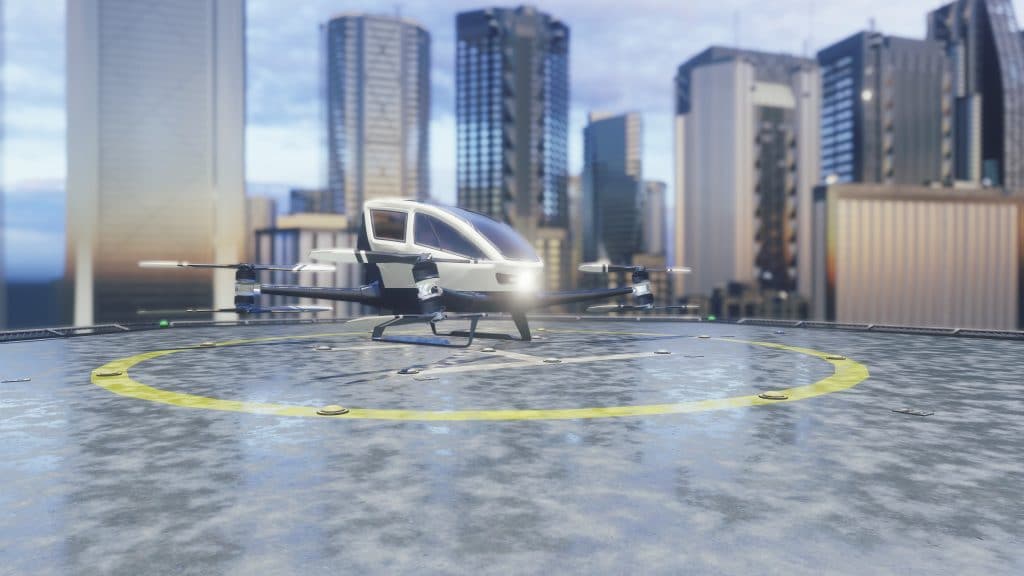Aviation Insurance: Keeping Pace with Technology
Technology drives the aerospace industry to new efficiencies and is reshaping future air mobility. Advances in technology can bring new risks, and aircraft builders as well as the associated supply chain rely on aviation product liability insurance to support their efforts by protecting them when something goes amiss.

Changes on the Horizon
Soon, we will see drones replacing delivery vans and people using urban air mobility. Supersonic airline travel and perhaps taking a ride to low Earth orbit are both within the realm of possibility too. Technologies including additive manufacturing (3D printing), stir welding, augmented reality (AR) and lithium-ion batteries, all of which were unheard of 20 years ago, are being used in the design and manufacturing process to support these emerging developments in aviation travel and transport.
What could go wrong? While pilot error remains the primary cause of accidents, new aircraft technology can also be a factor.
The Boeing 787 fleet was grounded in 2013 following lithium-ion battery thermal runaway events on two of the aircraft. Also in 2013, an Asiana Airlines B-777 crashed on approach at San Francisco due to the pilot’s misinterpretation of the flight control system, signaling an issue with the pilot-technology interface. In 1998, Swissair MD-11 went down offshore of Nova Scotia due to a fire caused by a new, state-of-the-art in-flight entertainment system, killing all onboard.
The Benefits of Product Liability Insurance
Product liability insurance protects the insured when defective products lead to claims. However, what is more common is the defense protection it offers, even if frivolous claims are made regardless of cause. The United State leads the world in the cost of litigation and the size of awards paid to plaintiffs, and that lead is growing. In recent years, the aviation insurance industry has witnessed multiple accidental death claims exceeding $50 million per claimant.
Aviation product liability insurance premiums are on the rise due to a long period of substantial premium reductions in combination with rising loss costs in recent years. That said, an aviation product liability policy is not expensive considering the protections it offers and the very high limits of liability that are available to provide the protection needed in the current legal environment.
Product Liability Insurance and the Drone Industry
In the unmanned aerial vehicle (UAV) or “drone” segment, product liability insurance remains critically important for the financial protection of the companies engaged in the advancement of new aviation technologies. The aviation insurance industry continues to innovate and develop new insurance products to support the technological advancements.
UAVs are relatively new but have become so prevalent that they are seen everywhere. The technology is pushing boundaries to go faster, fly farther and carry larger cameras, sensors and cargo. This requires improvements in batteries and electric motors to increase power while reducing weight. The technologies developed for UAVs are also accelerating growth of electric powered aircraft that are favored by manufacturers of urban and advanced air mobility aircraft.
Before the explosion in UAV popularity, product liability underwriters were comfortable with and accustomed to insuring original equipment manufacturers (OEMs) of aircraft, engines and their components. What was not foreseen was the pace of technological advancements with a new fleet of drones—aircraft weighing less than 10 kg and available through Amazon or Walmart. These drones can be piloted by anyone and today number over 1.3 million in the U.S. alone.
Underwriters evaluate new technology with the assistance of the manufacturers who are developing it. The drone market is much better understood today and this is, in no small part, a function of collaboration between the underwriting and manufacturing communities, which has allowed for a greater understanding of each other’s interests and concerns.
How to Address Advanced Air Mobility and Other Advances
Advanced air mobility is a new area in which Uber and Boeing have sponsored contests to determine who can develop the most workable new concepts. Uber wants to buy fleets of air mobility aircraft. Think of them as drones with passengers.
Not only do underwriters need to understand the challenges of this developing industry, but the FAA and other regulatory agencies have a large part to play in setting up a workable framework for integrating these aircraft into the national and international airspace systems. This is a work in progress, with many stakeholders engaged in the process.
The aerospace industry will continue to push the limits of technology. Around the corner, we see the industry working to bring an all-new supersonic airliner to market. The manufacturing and maintenance companies will take full advantage of 5G wireless technology in combination with augmented reality to design, build and maintain aircraft. With continued advances in artificial intelligence and digitalization, technology will be used to track every aircraft and its components, retaining the data of every production event, flight operation and maintenance procedure through its lifetime.
Global Aerospace’s Role as Technology Advances
At Global Aerospace, we will continue to partner with those in the aviation manufacturing industry to protect their changing needs. The basics of aviation product liability insurance protections don’t change, only the new risks created by the ever-evolving aerospace industry.




